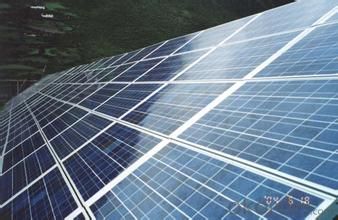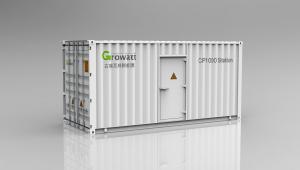Centralized Solar Inverter CP1000 Station,1260KW with TUV,EPEA,MEA,CE,CGC,LVRT,ZVRT 1.26MW
- Loading Port:
- Shekou
- Payment Terms:
- TT or LC
- Min Order Qty:
- 20 pc
- Supply Capability:
- 1000 pc/month
OKorder Service Pledge
OKorder Financial Service
You Might Also Like
1000kW integrated central inverter solution with DC distributed box and ac distributed box.
High conversion efficiency of 98.7% deliver more energy
Powerful grid management functions (including LVRT)
Active power continuous adjustment (0-100%)
Reactive power continuous adjustment (0-100%)
Integrated with SCADA monitoring system, totally compatible with smart-grid interface
Intelligent control, entirely meet the requirements of grid
Provide a turnkey solution, easy installation and maintenance
Comprehensive protection for overvoltage, islanding, short-circuit, overload, etc.
| CP1000 Station | CP1260 Station | |||
| Input data | ||||
| Max. DC power | 1150kW | 1450kW | ||
| Max. DC voltage | 1000V | 1000V | ||
| PV voltage range | 500V-1000V | 500V-1000V | ||
| MPP voltage range/nominal voltage | 500V-850V | 500V-850V | ||
| Rated Input voltage | 600V | 600V | ||
| Start voltage/power | 520V/10000W | 520V/12600W | ||
| Maximum Input current | 2240A | 2900A | ||
| Number of MPP trackers/strings per MPP tracker | 1 | 1 | ||
| Max. input current/per string | 2*10 | 2*10 | ||
| Output (AC) | ||||
| Rated AC output power | 1000kVA | 1000kVA | ||
| Rated AC voltage | 315V | 315V | ||
| AC voltage range | 250V-362V | 250V-362V | ||
| Rated frequency | 50Hz/60Hz | 50Hz/60Hz | ||
| Frequency Range | 45Hz-55Hz/55Hz-65Hz | 45Hz-55Hz/55Hz-65Hz | ||
| Rated Output Current | 1833A | 2310A | ||
| Maximum Output Current | 2016A | 2592A | ||
| Power factor | 0.9lagging-0.9leading | 0.9lagging-0.9leading | ||
| THDI | <3%(@Pac,r) | <3%(@Pac,r) | ||
| Efficiency | ||||
| Max. efficiency | 98.70% | 98.70% | ||
| Euro-eta | 98.50% | 98.50% | ||
| MPPT efficiency | 99.9% | 99.90% | ||
| Protection Devices | ||||
| DC disconnection device | DC circuit breaker | DC circuit breaker | ||
| AC disconnection device | AC circuit breaker | AC circuit breaker | ||
| DC overvoltage protection | Surge arrester type II | Surge arrester type II | ||
| AC overvoltage protection | Surge arrester type II | Surge arrester type II | ||
| Grid monitoring/Management | yes/yes | yes/yes | ||
| Ground monitoring | yes | yes | ||
| Over temperature protection | yes | yes | ||
| Insulation monitoring | yes | yes | ||
| General data | ||||
| Dimension (W/H/D)in mm | 3600/3000/2896 | 3600/3000/2896 | ||
| Weight | 6000KG | 6000KG | ||
| Operating Temperature Range | -25℃ ... +55℃ | -25℃ ... +55℃ | ||
| Relative Humidity | 0~95% | 0~95% | ||
| Degree of Protection | IP54 | IP54 | ||
| Noise Emission | 65dB(A)@1m | 65dB(A)@1m | ||
| Maximum Operating Altitude | 6000m(Derating over 3000m) | 6000m(Derating over 3000m) | ||
| Standby consumption | <200W | <200W | ||
| Cooling | Air forcedl | Air forcedl | ||
| Topology | Transformerless | Transformerless | ||
| Display | Touch screen LCD | Touch screen LCD | ||
| Communication Interface | RS485/Ethernet | RS485/Ethern | ||
| Certificates and ApprovalsCE, TUV, CGC, LVRT, ZVRT, PEA, G59 | ||||


FAQ
1. Have any design tool and how to use it?
Shine Design is the system design software just for inverters, It can conduct installers to figure out panel numbers for a system, panel numbers for each string, and which inverter model is suitable for the system. Moreover, it can print a design report after input all necessary parameters, can calculate DC/AC wire wastage, annual generation, etc.
2. Does the inverter have monitoring solutions for residential system?
For small rating system, we have wired two monitoring solution (ShineNet via RS232 or RS485). (a) Local wireless monitoring solution (ShineVision via RF module communication) (b) Global wireless monitoring solution (WIFI module via WIFI network)
3. Do you have free solution for monitoring?
ShineNet is an inverter monitoring software run in Windows XP, Windows Vista, Windows 7 operating system. It can monitor inverter via RS232 (or RS232 convert to USB cable) and RS485 wire connection. Customers can purchase the cable locally to get the inverter monitored, it is simple.
- Q:What is the purpose of a solar inverter in a solar power system?
- The purpose of a solar inverter in a solar power system is to convert the direct current (DC) electricity generated by the solar panels into alternating current (AC) electricity that can be used to power household appliances or be fed back into the grid.
- Q:Can a solar inverter be used in regions with high temperature extremes?
- Yes, solar inverters can be used in regions with high temperature extremes. However, it is important to consider the temperature range specified by the manufacturer for optimal performance and efficiency. Extreme heat may affect the inverter's efficiency and longevity, so proper cooling and ventilation should be ensured in such conditions.
- Q:Can a solar inverter be used with a solar-powered air purification system?
- Yes, a solar inverter can be used with a solar-powered air purification system. A solar inverter converts the direct current (DC) generated by solar panels into usable alternating current (AC) electricity, which can power various appliances or devices, including air purification systems. By connecting a solar inverter to a solar-powered air purification system, it can efficiently operate using renewable energy from the sun.
- Q:How does a solar inverter handle voltage sag or drop in the grid?
- A solar inverter handles voltage sag or drop in the grid by continuously monitoring the grid voltage. When it detects a drop below a certain threshold, it adjusts its own output voltage to compensate and maintain a stable and consistent voltage supply to the connected solar panels or the grid. This ensures that the solar system operates optimally and can seamlessly adapt to any fluctuations in the grid voltage.
- Q:What is the maximum input voltage that a solar inverter can handle?
- The maximum input voltage that a solar inverter can handle varies depending on the specific model and manufacturer. However, in general, most solar inverters can handle input voltages in the range of 600 to 1000 volts DC.
- Q:Can a solar inverter be used with a grid-interactive system?
- Yes, a solar inverter can be used with a grid-interactive system. A grid-interactive system allows for the solar inverter to convert the DC power generated by the solar panels into AC power that can be used to power the home or business. It also allows for excess power to be fed back into the grid, thus reducing energy costs and providing additional benefits such as net metering.
- Q:Are there any safety risks associated with solar inverters?
- Yes, there are some safety risks associated with solar inverters. These risks primarily include electric shock and fire hazards. It is important to ensure proper installation, grounding, and maintenance of solar inverters to minimize these risks. Additionally, regular inspections and adherence to safety guidelines are crucial to mitigate any potential hazards.
- Q:How does a solar inverter handle voltage fluctuations from the battery bank?
- A solar inverter handles voltage fluctuations from the battery bank by regulating and stabilizing the incoming DC voltage from the batteries. It converts the fluctuating DC voltage into a stable AC voltage, ensuring a consistent power supply to the connected devices or grid.
- Q:What are the safety features of a solar inverter?
- The safety features of a solar inverter typically include surge protection, overvoltage protection, short circuit protection, ground fault detection, and overtemperature protection. These features help to prevent damage to the inverter and the electrical system, ensuring safe and reliable operation.
- Q:What is the difference between a central inverter and a string inverter?
- A central inverter is a type of inverter that is used in large-scale solar installations. It takes the direct current (DC) electricity generated by multiple solar panels and converts it into alternating current (AC) electricity that can be used to power homes or businesses. A central inverter is typically located in a central location, such as a utility room or basement. On the other hand, a string inverter is a type of inverter that is used in smaller-scale solar installations. It also converts DC electricity from multiple solar panels into AC electricity, but it does so at the string level. This means that each string of solar panels has its own dedicated inverter. String inverters are usually installed near the solar panels themselves, which can make them more convenient for maintenance and troubleshooting. In summary, the main difference between a central inverter and a string inverter is the scale of the solar installation they are used in and their physical location. Central inverters are used in larger installations and are located centrally, while string inverters are used in smaller installations and are located near the solar panels.
1. Manufacturer Overview |
|
|---|---|
| Location | |
| Year Established | |
| Annual Output Value | |
| Main Markets | |
| Company Certifications | |
2. Manufacturer Certificates |
|
|---|---|
| a) Certification Name | |
| Range | |
| Reference | |
| Validity Period | |
3. Manufacturer Capability |
|
|---|---|
| a)Trade Capacity | |
| Nearest Port | |
| Export Percentage | |
| No.of Employees in Trade Department | |
| Language Spoken: | |
| b)Factory Information | |
| Factory Size: | |
| No. of Production Lines | |
| Contract Manufacturing | |
| Product Price Range | |
Send your message to us
Centralized Solar Inverter CP1000 Station,1260KW with TUV,EPEA,MEA,CE,CGC,LVRT,ZVRT 1.26MW
- Loading Port:
- Shekou
- Payment Terms:
- TT or LC
- Min Order Qty:
- 20 pc
- Supply Capability:
- 1000 pc/month
OKorder Service Pledge
OKorder Financial Service
Similar products
New products
Hot products
Hot Searches
Related keywords































